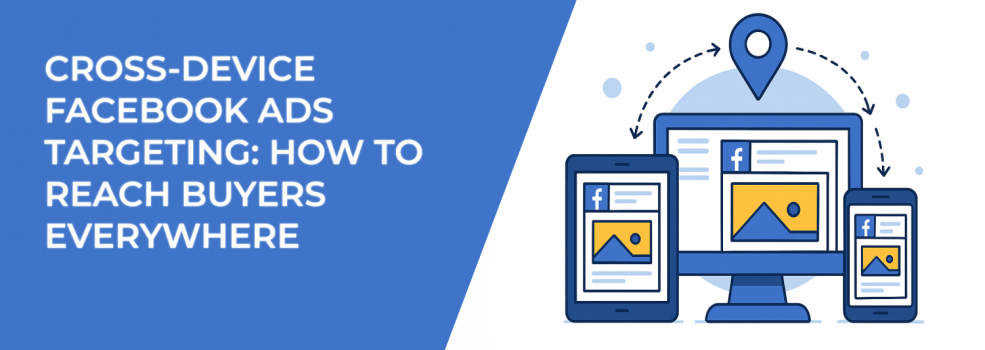Running Facebook ads used to be straightforward. You placed an ad on desktop, people clicked, and some converted. Simple. Today, buyers bounce between devices constantly — checking social on phones in the morning, browsing on tablets at night, and completing purchases on work computers during the day. If you aren’t accounting for those shifts, you’re leaving both data and revenue on the table.
Cross-device Facebook ads targeting bridges that gap. It reveals not only who converted, but the full journey across screens. With that picture in hand, you can cut wasted spend, allocate budgets more effectively, and design campaigns that match how people really shop.
What Exactly Is Cross-Device Facebook Ads Targeting?
Cross-device targeting means you’re tracking and reaching people as they move across multiple devices. A common path looks like this:
-
See your ad on Instagram while scrolling on a phone,
-
Tap through, poke around on a tablet later,
-
Finally complete the purchase on a desktop.
If you only looked at the last device — the desktop — you’d assume mobile ads didn’t pull their weight. In reality, that first mobile impression sparked the whole purchase journey.
Cross-device reporting connects those dots. You capture impressions, clicks, and conversions across the device mix, so you can value each touchpoint correctly and avoid over-crediting the last click.
Want a quick refresher on reaching the right people before you track them across screens? Check out Facebook Ad Targeting 101: How to Reach the Right Audience.
Why Cross-Device Targeting Matters Right Now
The way people shop keeps shifting. Mobile traffic dominates, yet many purchases still finalize on desktop. Consider the practical implications:
-
Mobile often drives discovery and consideration; desktop often closes.
-
Switching devices mid-journey is normal, not an edge case.
-
Last-click views routinely undervalue upper-funnel mobile impressions.
If you don’t measure cross-device behavior, you risk cutting campaigns that are quietly doing the early heavy lifting. You also miss device-specific optimization opportunities. Curious which device pairing (mobile → desktop, desktop → mobile, app → desktop) drives your best return?
Set Up Cross-Device Reporting (Step by Step)
Before cross-device insights show up in your dashboards, get the foundations right:
-
Install the Meta pixel on both desktop and mobile versions of your site.
-
Add the Facebook SDK to your mobile app (if you have one).
-
Configure app and web events you care about (Purchase, Lead, AddToCart, CompleteRegistration).
-
Select the right event at the ad set level so Meta can attribute conversions properly.
Once this is done, your reports can show the device where the ad was seen (impression device) and the device where the conversion happened (conversion device). Seeing both changes how you evaluate performance.
Where to View Cross-Device Data in Meta Ads Manager
You can surface cross-device insights directly in Ads Manager:
-
Open the campaign, ad set, or ad.
-
Click Breakdown.
-
Under By delivery, choose Impression device.
-
Under By action, choose Conversion device.
That side-by-side view exposes the real flow: mobile impressions that later convert on desktop, desktop impressions that drive app installs, and tablet sessions that re-activate email subscribers.
Prefer a more customizable report? Head to Ads Reporting:
-
Open Reports and select a saved report.
-
Use Search by columns to add Impression device or Conversion device.
-
Or open the three-dot menu, hover over Selected columns, and add those fields.
Seeing “N/A” or “Other”? “N/A” appears when your date range includes days before July 3, 2014, or when no conversions occurred. “Other” buckets devices like Amazon Fire, Windows phones, and feature phones.
Turn Cross-Device Insights into Better Results
Data matters only if you act on it. Here’s how to operationalize cross-device reporting:
1) Budget and Bidding
If mobile impressions kick off most journeys while desktop closes, keep funding both roles. Use bid strategies that respect the funnel stage — for example, more aggressive bidding on desktop acquisition while sustaining efficient mobile reach for top-of-funnel.
2) Creative by Device
People don’t use their phone the same way they use a computer. On a small screen, they want quick, easy content. On a bigger screen, they’re more open to reading details.
- Mobile: Keep it short and punchy. Use vertical videos, bold headlines, and clear visuals that grab attention fast.
- Desktop: Share more detail. Use carousels or collection ads to show product options, reviews, and answers to common questions.
By matching your ad style to the device, you make it easier for people to connect and take action.
3) Sequenced Retargeting
When someone engages on mobile but stalls, follow up on desktop with a format that “finishes the job” — detailed offer, stronger urgency, or richer proof. If your audience uses your app, build app-centric sequences that bring them back to an in-app PDP.
For a deep dive on the mechanics, bookmark How to Set Up Facebook Retargeting.
4) Conversion Path Experiments
Treat device paths like hypotheses to test:
-
Mobile → Desktop checkout vs. Mobile → App checkout
-
Desktop research → Mobile purchase with wallet payments
-
App browse → Desktop purchase for larger baskets
Align landing pages and checkout UX to the most common path. Even small steps — like prefilled forms on desktop for users who started on mobile — can lift conversion rate.
5) Measurement Beyond CTR and CPC
Cross-device journeys expose how superficial single-metric views can be. Layer in path-aware KPIs: view-through assists by device, add-to-cart rate by entry device, and conversion rate by final device.
When you’re ready to level up your analysis, read How to Analyze Facebook Ad Performance Beyond CTR and CPC.
Troubleshooting: Common Cross-Device Pitfalls
-
Incomplete pixel or SDK setup: If events fire on desktop but not mobile (or vice versa), your cross-device view will be skewed. Audit event parity.
-
Attribution windows not aligned with your sales cycle: Long consideration cycles need longer windows to capture assists accurately.
-
Over-reliance on last-click: You’ll underfund mobile discovery and overfund desktop closer ads.
-
Mismatched landing pages: Mobile pages with heavy scripts or confusing forms cause abandonment — which then shows up as “desktop saves the day.” Fix mobile UX first.
-
Audience overlap across device-specific ad sets: Duplicate reach inflates frequency and wastes budget.
Struggling to diagnose performance dips while juggling devices and placements? This primer helps: Facebook Ads Not Converting: How To Fix It.
Pro Tips for Smarter Cross-Device Targeting
-
Use device-aware exclusions: If someone purchased on desktop today, exclude them from aggressive desktop prospecting tomorrow and switch to a lighter mobile upsell.
-
Structure naming for clarity: Include ImpressionDevice_TargetDevice in ad set names (e.g., Prospecting_Mobile-Impression → Desktop-Conversion). Your future self will thank you during reporting.
-
Mind creative weight on mobile: Compress images, keep motion snappy, and front-load value. Slow loads kill cross-device paths at the start.
-
Sync offers to context: App-only perks for app users, buy-now bundles for desktop checkouts, and tap-to-text for service businesses on mobile.
-
QA your events after releases: New app builds or site changes can silently break event firing on a single device group.
Planning campaigns from the objective down — rather than forcing objectives to fit a fixed plan — makes cross-device optimization much easier. If you need a refresher, read Meta Ad Campaign Objectives Explained: How to Choose the Right One.
The Bottom Line
Cross-device Facebook ads targeting is essential in a multi-screen world. When you see the full journey — impression device and conversion device — you make smarter calls about budget, creative, and retargeting. You reduce waste. You lift conversion rate. Most importantly, you build an operation that matches how people actually buy.
Your audience is everywhere. With cross-device reporting, your measurement is too — and your strategy finally keeps up.

